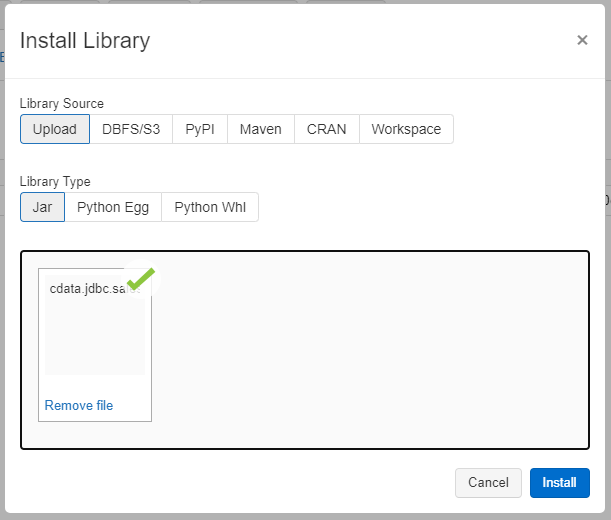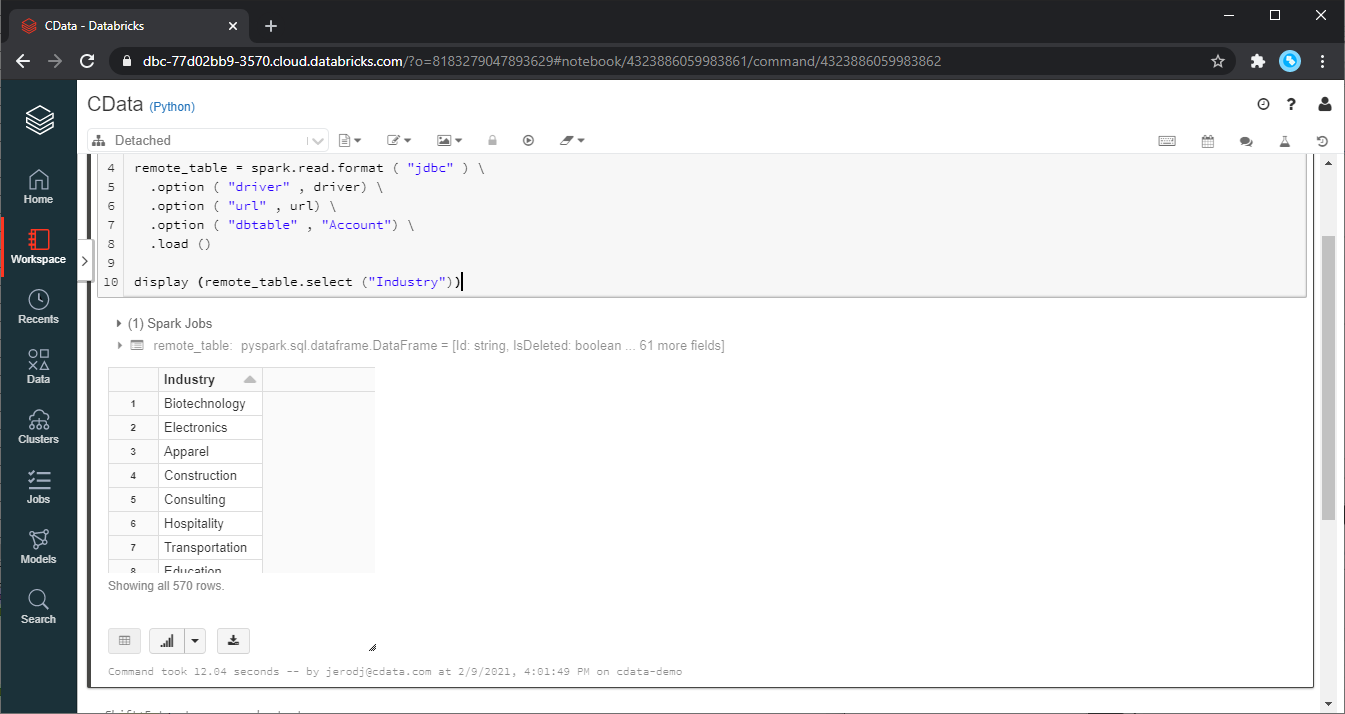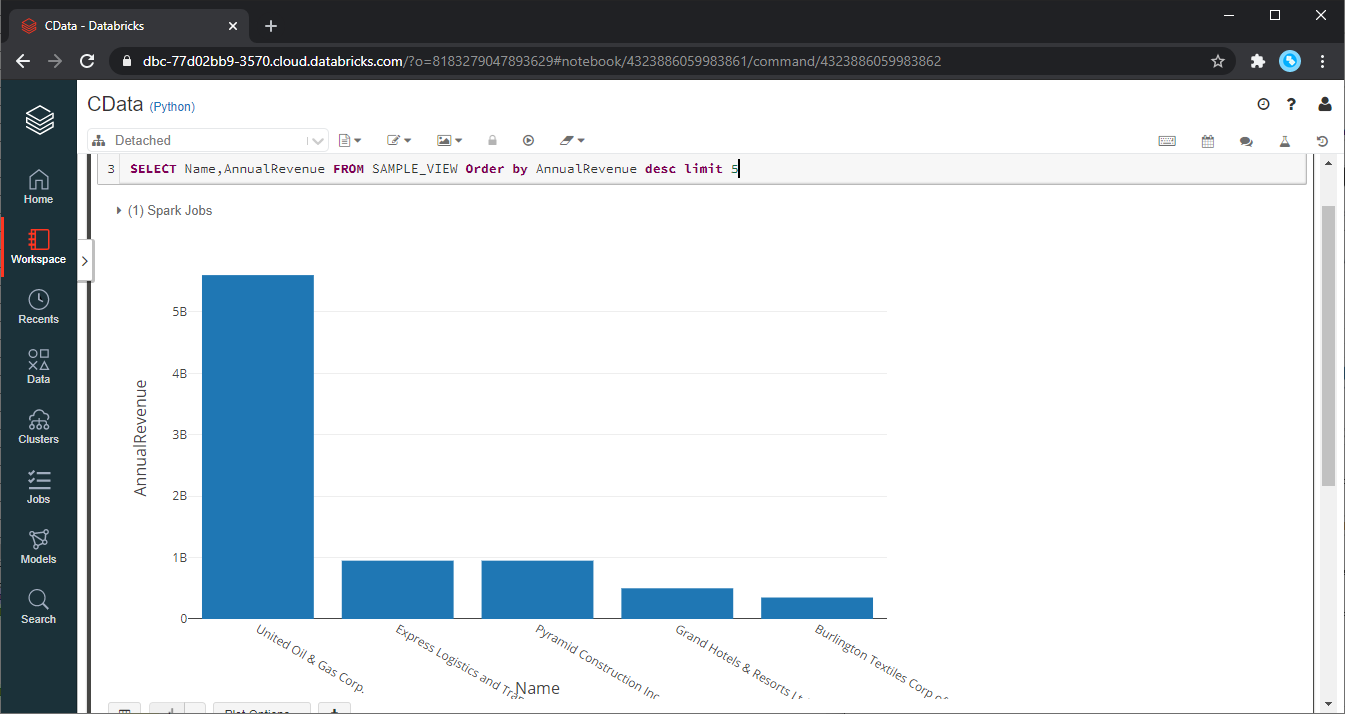Discover how a bimodal integration strategy can address the major data management challenges facing your organization today.
Get the Report →Process & Analyze SAP SuccessFactors Data in Databricks (AWS)
Use CData, AWS, and Databricks to perform data engineering and data science on live SAP SuccessFactors Data.
Databricks is a cloud-based service that provides data processing capabilities through Apache Spark. When paired with the CData JDBC Driver, customers can use Databricks to perform data engineering and data science on live SAP SuccessFactors data. This article walks through hosting the CData JDBC Driver in AWS, as well as connecting to and processing live SAP SuccessFactors data in Databricks.
With built-in optimized data processing, the CData JDBC Driver offers unmatched performance for interacting with live SAP SuccessFactors data. When you issue complex SQL queries to SAP SuccessFactors, the driver pushes supported SQL operations, like filters and aggregations, directly to SAP SuccessFactors and utilizes the embedded SQL engine to process unsupported operations client-side (often SQL functions and JOIN operations). Its built-in dynamic metadata querying allows you to work with and analyze SAP SuccessFactors data using native data types.
Install the CData JDBC Driver in Databricks
To work with live SAP SuccessFactors data in Databricks, install the driver on your Databricks cluster.
- Navigate to your Databricks administration screen and select the target cluster.
- On the Libraries tab, click "Install New."
- Select "Upload" as the Library Source and "Jar" as the Library Type.
- Upload the JDBC JAR file (cdata.jdbc.sapsuccessfactors.jar) from the installation location (typically C:\Program Files\CData[product_name]\lib).

Access SAP SuccessFactors Data in your Notebook: Python
With the JAR file installed, we are ready to work with live SAP SuccessFactors data in Databricks. Start by creating a new notebook in your workspace. Name the notebook, select Python as the language (though Scala is available as well), and choose the cluster where you installed the JDBC driver. When the notebook launches, we can configure the connection, query SAP SuccessFactors, and create a basic report.
Configure the Connection to SAP SuccessFactors
Connect to SAP SuccessFactors by referencing the JDBC Driver class and constructing a connection string to use in the JDBC URL. Additionally, you will need to set the RTK property in the JDBC URL (unless you are using a Beta driver). You can view the licensing file included in the installation for information on how to set this property.
Step 1: Connection Information
driver = "cdata.jdbc.sapsuccessfactors.SAPSuccessFactorsDriver" url = "jdbc:sapsuccessfactors:RTK=5246...;User=username;Password=password;CompanyId=CompanyId;Url=https://api4.successfactors.com;"
Built-in Connection String Designer
For assistance in constructing the JDBC URL, use the connection string designer built into the SAP SuccessFactors JDBC Driver. Either double-click the JAR file or execute the jar file from the command-line.
java -jar cdata.jdbc.sapsuccessfactors.jar
Fill in the connection properties and copy the connection string to the clipboard.
You can authenticate to SAP Success Factors using Basic authentication or OAuth with SAML assertion.
Basic Authentication
You must provide values for the following properties to successfully authenticate to SAP Success Factors. Note that the provider will reuse the session opened by SAP Success Factors using cookies. Which means that your credentials will be used only on the first request to open the session. After that, cookies returned from SAP Success Factors will be used for authentication.
- Url: set this to the URL of the server hosting Success Factors. Some of the servers are listed in the SAP support documentation (external link).
- User: set this to the username of your account.
- Password: set this to the password of your account.
- CompanyId: set this to the unique identifier of your company.
OAuth Authentication
You must provide values for the following properties, which will be used to get the access token.
- Url: set this to the URL of the server hosting Success Factors. Some of the servers are listed in the SAP support documentation (external link).
- User: set this to the username of your account.
- CompanyId: set this to the unique identifier of your company.
- OAuthClientId: set this to the API Key that was generated in API Center.
- OAuthClientSecret: the X.509 private key used to sign SAML assertion. The private key can be found in the certificate you downloaded in Registering your OAuth Client Application.
- InitiateOAuth: set this to GETANDREFRESH.

Load SAP SuccessFactors Data
Once you configure the connection, you can load SAP SuccessFactors data as a dataframe using the CData JDBC Driver and the connection information.
Step 2: Reading the data
remote_table = spark.read.format ( "jdbc" ) \ .option ( "driver" , driver) \ .option ( "url" , url) \ .option ( "dbtable" , "ExtAddressInfo") \ .load ()
Display SAP SuccessFactors Data
Check the loaded SAP SuccessFactors data by calling the display function.
Step 3: Checking the result
display (remote_table.select ("address1"))

Analyze SAP SuccessFactors Data in Databricks
If you want to process data with Databricks SparkSQL, register the loaded data as a Temp View.
Step 4: Create a view or table
remote_table.createOrReplaceTempView ( "SAMPLE_VIEW" )
With the Temp View created, you can use SparkSQL to retrieve the SAP SuccessFactors data for reporting, visualization, and analysis.
% sql SELECT address1, zipCode FROM SAMPLE_VIEW ORDER BY zipCode DESC LIMIT 5

The data from SAP SuccessFactors is only available in the target notebook. If you want to use it with other users, save it as a table.
remote_table.write.format ( "parquet" ) .saveAsTable ( "SAMPLE_TABLE" )
Download a free, 30-day trial of the CData JDBC Driver for SAP SuccessFactors and start working with your live SAP SuccessFactors data in Databricks. Reach out to our Support Team if you have any questions.






